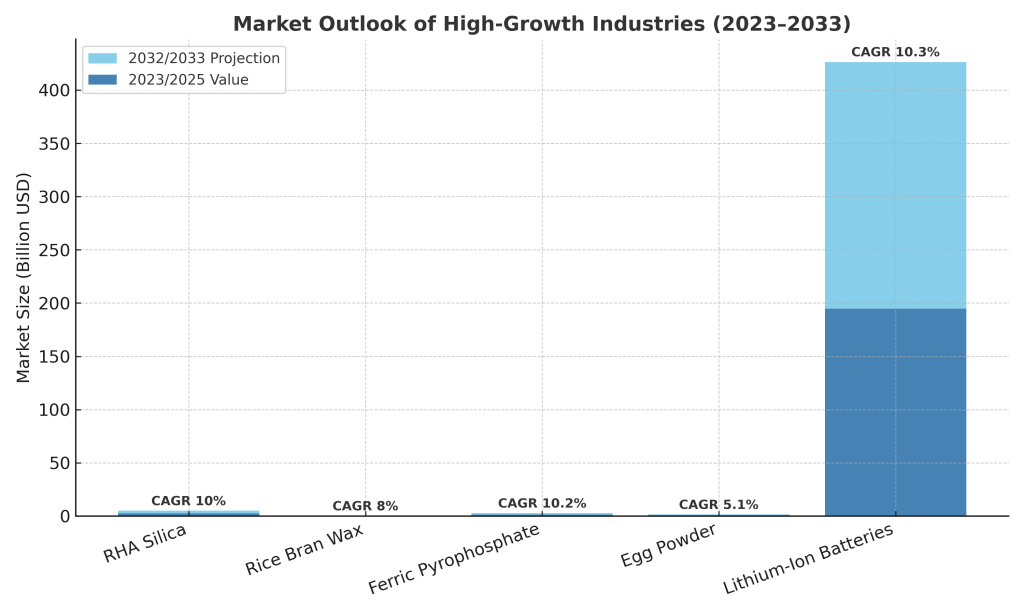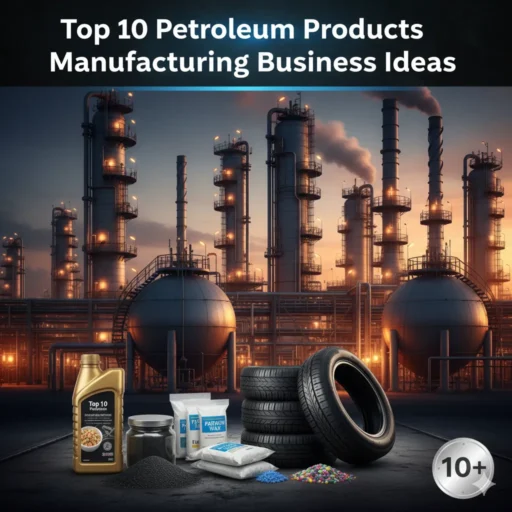This report offers a comprehensive analysis of eight distinct and rapidly growing product categories. It is aimed at both aspiring business leaders and those who are already established. Each sector, from immersive entertainment to sustainable materials, offers a fertile environment for innovation.
This guide offers a detailed and concise overview of the market dynamics, regulatory landscape, and technological underpinnings. It offers actionable insights for new ventures to be successful in High Growth Industries in India in a global market.
New Generation of Sustainable Materials
Globally, the increasing emphasis on environmental responsibility is causing a boom in demand for eco-friendly and sustainable materials. This change presents entrepreneurs with a unique opportunity to innovate and gain market share in an industry that is rapidly growing.

Silica from Rice Husk Ash as a Sustainable Building Material
RHA, an agricultural byproduct, is a rich and versatile source of amorphous silicon. Its unique characteristics, such as its high porosity and chemical inertness, make it an important material in multiple industries. Construction is one of them.
- Sustainability Advantage: RHA-based silica is an eco-friendly, renewable alternative to synthetic silica. It reduces dependence on non-renewable sources and offers a solution for the management of agricultural waste.
- Market Dynamics: The global market for RHA precipitated silica has experienced a robust growth driven by an expanding construction industry and increasing demand for sustainable products. Market size was estimated to be $2.5 billion around 2023, and it is expected to grow to 5 billion in 2033 with a CAGR of 8-10%. Some projections suggest a CAGR as high as 12.1%.
- Production and regional dominance: Asia, especially East Asia (China, Japan, South Korea) dominates the production, accounting for over 60% of the global market. South and Southeast Asia are also significant.
- Manufacturing Insights: The process of production involves controlled combustion, followed by a chemistry process to dissolve the silica and precipitate it. This low-temperature process offers potential for energy savings and steam cogeneration.
- Start-ups have many opportunities:
- Companies can target high-purity RHA silicon at high-value sectors such as biomedicine, pharmaceuticals, and electronics.
- Eco-Friendly Labeling: The inherent sustainability of RHA silica is a powerful tool for marketing.
- Supply Chain Integration: Establishing strong relationships with rice mills will ensure a constant supply of raw materials.
Related: 15 High-Demand Manufacturing Startup Ideas for MSMEs and New Entrepreneurs
| Metric | 2023 Value | 2033 Projection | CAGR (2025-2033). | Key Drivers |
| Market Size | $2.5 Billion | $5 Billion | 8-12.1% | Sustainable Construction and Growing Demand |
| Concentration of Production | N/A | N/A | N/A | Asia (China > 60%) |
Rice Bran Wax – Value of Byproducts
Processors extract rice bran wax during the refinement of rice bran oils, and it serves as a biodegradable and renewable alternative to petroleum-based waxes. The high melting point of the wax and its excellent lubricating qualities are driving its use across many industries.
- Applications: Industries use this versatile wax in food-grade lubricants, personal care products, cosmetics, and pharmaceuticals. Manufacturers also replace carnauba with it and apply it in waterproofing.
- Market Dynamics: The global market for rice bran wax is expected to grow at a significant rate. Its projected growth will be from $150 million in 2020 to almost $250 million by 2033. This represents a CAGR around 8%.
- Due to extensive rice farming, the Asia-Pacific region will dominate the market.
- Purification Process: To achieve food-grade quality, the crude wax obtained from rice bran oil is purified in a multi-stage process that includes solvent extraction and mechanical extraction.
- Start-ups have many opportunities:
- High-Purity Applications – Focusing on food-grade or pharmaceutical-grade waxes can command premium prices.
- Sustainability as a key selling point: Stressing the eco-friendly aspect of a product can attract environmentally aware consumers.
- Collaboration with Oil Producers: Strategic partnerships can be formed with rice bran oil manufacturers to ensure a steady supply of raw materials.
View our Books for more information
| Metric | 2025 Value (Est.) | 2033 Projection (Est.) | CAGR (2025-2033). | Key Drivers |
| Market Size | $1 Billion | 250 Million Dollars | 8% | Eco-friendly Demand, Unique Properties |
| Dominant Region | Asia-Pacific | Asia-Pacific | N/A | Substantial Rice Crops |
Health and Nutrition:
Fortified foods and nutritional supplements are booming due to the growing awareness of health, wellness, and nutrition.
Ferric Pyrophosphate as a Key Ingredient in Nutritional Fortification
Ferric Pyrophosphate is a bioavailable iron compound widely used in food fortification without changing the taste or color. It is therefore a valuable ingredient in the fight against iron deficiencies.
- FPP has a wide range of applications, including iron supplements, cereals for infants, and powdered drinks. Primary end-users include the food and beverage and pharmaceutical industries.
- Market Dynamics: Analysts valued the global Ferric Pyrophosphate market at approximately $1.32 billion in 2024, and they project it to grow to $2.89 billion by 2032 with a CAGR of 10.2%. Experts also expect the FPP market segment to reach $618.1 million by 2032.
- Manufacturing Process: Liquid phase precipitation is the most common way to produce FPP. This involves a reaction of soluble iron and pyrophosphate salts in aqueous solutions.
- Start-ups have many opportunities:
- Focus on high-purity grades: The demand for FPP pharmaceutical grade offers greater value.
- Functional Modifications: Adding other nutrients, such as Vitamin C, during production can result in value-added goods.
- Food and pharmaceutical applications require a robust quality control system to ensure high standards of purity, safety and security.
View our Project reports for more information
| Metric | 2024 Value | 2032 Projection | CAGR (2026-2032). | Key Applications |
| Market Size | $1.32 Billion | $2.89 Billion | 10.2% | Iron Supplements, Food Fortification |
| Iron Phosphate Market Segment FPP | N/A | 618.1 Million Dollars | 5.4% | Anemia (a blood disorder) |
Egg powder: A convenient nutritional powerhouse
The dehydrated form, egg powder, is a convenient way to get the nutrition of fresh eggs and a longer shelf life. Its versatility makes it a favorite ingredient for the food industry and health-conscious consumers.
- Key Applications: The egg powder is used to make a variety of products, including baking mixes, sauces and noodles, sports nutrition, emergency food, and bakery mixes.
- Market Dynamics: The global market for egg powder was valued at $923.7 million in 2022, and is expected to reach $1.5 billion by 2032 with a CAGR of 5.1%.
- Production Process: To produce egg powder, fresh eggs are sanitized and broken, then homogenized, pasteurized, and spray-dried.
- Start-ups have many opportunities:
- Food Safety and Quality Certificates: It is important to adhere to strict standards of food safety, particularly for export markets.
- Food service and processing industries are the key segments for B2B sales.
- Diversification of Products: Manufacturers can offer customized blends, such as protein-fortified or flavored powders, to cater to niche markets.
| Metric | 2022 Value | 2032 Projection | CAGR (2023-2032). | Dominant Region |
| Global Market Size | $923.7 Million | $1.5 Billion | 5.1% | Asia-Pacific |
| U.S. Market size (2024-2033). | 960 Million Dollars (2024) | $1.4 Billion (2033) | 3.99% | North America |
Related: How to Start a Manufacturing Business of Egg Powder
The Future of Energy and Technology
Entrepreneurs in the energy sector and technology sectors are experiencing unprecedented growth opportunities as a result of the global shift towards cleaner energy.
The Electric Revolution is Fueled by Lithium-Ion Batteries
Battery packs containing lithium-ion (Li-ion) have become essential in modern technology. They power everything from consumer electronics to electric vehicles, and even large-scale energy-storage systems.
- Electric vehicles (EVs), Energy Storage Systems (ESS), and consumer electronics are the primary drivers of Li-ion batteries. Medical and industrial applications are also on the rise.
- Market Dynamics: According to projections, the global lithium-ion market will grow from $194.66 billion in 2025 to 426.37 billion by 2033 at a CAGRof 10.3%.
- Regional Dominance: In 2025, the Asia-Pacific region will hold the largest share of the market due to high demand for EVs as well as significant investments made in battery manufacturing.
- Manufacturing and assembly: Although full-scale manufacturing of cells requires substantial investment, startup companies can enter the market by assembling battery packs, which is a lower entry barrier.
- Start-ups have many opportunities:
- Niche Pack Assembly: By focusing on niche markets such as e-bikes or power tools for home backup systems, customized solutions can be created.
- LFP Chemistry: Lithium Iron Phosphate chemistry (LFP) is becoming more popular due to its low cost and long life.
- Compliance with environmental regulations is essential for success on the long term.
| Metric | 2025 Value | 2033 Projection | CAGR (2025-2033). | The Key Drivers |
| Market Size | $194.66 Billion | $426.37 Billion | 10.3% | Consumer Electronics, Energy Storage and EVs |
| Dominant Region | Asia-Pacific | Asia-Pacific | N/A | Concentration of manufacturing in areas with high EV demand |
For information, check out this related video
Organic Acids and Hospitality: A Versatile World of Organic Acids
These sectors provide a variety of opportunities for entrepreneurs. From the production of memorable experiences to essential food additives, they offer a wide range of entrepreneurial ventures.
Citric Acid – The ubiquitous organic acid
Citrus fruits naturally contain citric acid, a weak organic acid. Manufacturers widely use this versatile additive in the food, beverage, pharmaceutical, and personal care industries.
- Core Applications: It is used as a preservative and pH regulator, in addition to being a flavoring agent.
- Market Dynamics: Citric acid is one of the fastest-growing markets in the world, but prices can fluctuate due to disruptions in supply chains. The processed food, beverages, and personal care industries are strong demand drivers.
- Manufacturing Process: Aspergillus Niiger is the most common microorganism used in the production process.
- Start-ups have many opportunities:
- Localized production: By establishing local production facilities, you can reduce the risk of global supply chain disruptions.
- Sustainable Production Methods: Investing in eco-friendly methods like solid-state fermenting can give you a competitive advantage.
- Focus on High-Growth Industry: Concentrating your efforts on industries with constant demand, like confectionery and pharmaceuticals, can help you to create a stable market.
The 3-Star Hotel: Amid the Mid-Market Boom, cater to the Mid-Market Boom
This segment offers a comfortable and convenient stay for travelers of all types, with a great value proposition. This segment has immense potential in a market that is rapidly growing, such as India.
Cost
| Cost | A |
| Land Development Cost | 50.00 |
| Civil Works and Buildings | 631.75 |
| Fixed | 914.17 |
| Miscellaneous Fixed Assets | 18.11 |
| D.G. Set | 4.40 |
| Escalation & Contingencies | 80.92 |
| Cost | 65.57 |
| Total | 1,896.48 |
Discover the Right Business for You With Our Startup Selector Tool
Conclusion and key entrepreneurial takeaways
Researchers analyze eight product categories and highlight a variety of entrepreneurial opportunities. These diverse sectors feature several key themes that entrepreneurs must leverage to achieve success.
- Sustainable practices are no longer a trend, but rather a competitive advantage in an environmentally-conscious world.
- Prioritize quality and differentiation: Unique value propositions and high-quality products are crucial for capturing and maintaining market share.
- Navigate the Regulatory Landscape. It is important to be proactive in interacting with regulatory requirements and adhering to them. This will help you avoid legal pitfalls and ensure smooth operations.
- Leverage Technology and Innovation. Constant investment in technology and commitment to innovation is key to staying on top of a dynamic global market that is dynamic.
Entrepreneurs can navigate the complexity of modern industries by focusing on strategic imperatives. They will also position their startup for long-term success and growth.







